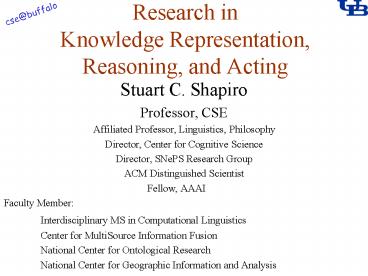Research in Knowledge Representation, Reasoning, and Acting - PowerPoint PPT Presentation
Title:
Research in Knowledge Representation, Reasoning, and Acting
Description:
Title: ResearchOverview '06 Author: Stuart C. Shapiro Last modified by: Stuart C. Shapiro Created Date: 7/31/2001 3:37:56 AM Document presentation format – PowerPoint PPT presentation
Number of Views:79
Avg rating:3.0/5.0
Title: Research in Knowledge Representation, Reasoning, and Acting
1
Research inKnowledge Representation, Reasoning,
and Acting
- Stuart C. Shapiro
- Professor, CSE
- Affiliated Professor, Linguistics, Philosophy
- Director, Center for Cognitive Science
- Director, SNePS Research Group
- ACM Distinguished Scientist
- Fellow, AAAI
- Faculty Member
- Interdisciplinary MS in Computational
Linguistics - Center for MultiSource Information Fusion
- National Center for Ontological Research
- National Center for Geographic Information and
Analysis
2
Long-Term Goal
- Theory and Implementation of
- Natural-Language-Competent
- Computerized Cognitive Agent/Robot
- and Supporting Research in
- Artificial Intelligence
- Cognitive Science
- Computational Linguistics
- with application-oriented spinoffs.
3
Cassie
- A computational cognitive agent
- Embodied in hardware
- or software-simulated
- Based on SNePS and (M)GLAIR.
4
MGLAIR Agent Architecture
Mind
KL (SNePS)
Independent of lower-body implementation
Body
PMLa
PMLb
Dependent on lower-body implementation
I/P s o c k e t s
PMLc
Proprioception
Speech
W O R L D
Hearing
SAL
Vision
Motion
5
SNePS
- SNePS is a
- Logic-Based
- Frame-Based
- Network-Based
- knowledge representation, reasoning, and acting
system.
6
Example Knowledge Base
- As logical assertions
- wff1! Inst(Albany,Syracuse,Rochester,Buffalo,
City) - wff2! WestOf(Buffalo,Rochester)
- wff3! WestOf(Rochester,Syracuse)
- wff4! WestOf(Syracuse,Albany)
- As frames
- (m1! (class City) (member Albany
Syracuse Rochester Buffalo)) - (m2! (east Rochester) (west Buffalo))
- (m3! (east Syracuse) (west Rochester))
- (m4! (east Albany) (west Syracuse))
7
Example KB as a Network
8
Some Important SNePS Features
- First-person beliefs
- Not third-person truth about agent or world
- Beliefs are current beliefs
- Even if about the past
- On-line acting
- Reified propositions as well as acts
- Neither states nor times are privileged
9
Some Recent CurrentProjects
- A General Characterization of Answers to
Questions - KRR for Information Fusion for Cyber Security
- Ontology Tool
- Logic of Arbitrary and Indefinite Objects
- Intermedia Performance Studio
- Actor-agents in VR drama
10
A General Characterization of Answers to Questions
- Every clause descended from a query clause in
resolution theorem proving is an answer to the
query. - General form of an answer
- H ? G ? Q
- H is Hypothetical component (optional)
- G is Generic component (optional)
- Q is Question component (either generic or
specific) - Example
- Cat(Boots), Tuna(x), Answer(Likes(Boots, x))
- Cat(Boots) ? ?x (Tuna(x) ? Likes (Boots, x))
- If Boots is a cat, then Boots likes to eat any
tuna. - D. T. Burhans S. C. Shapiro, Defining Answer
Classes Using Resolution Refutation, Journal of
Applied Logic 5,1 (March 2007), 70-91.
11
KRR forInformation Fusionin the Cyber Security
Domain
- Use SNePS to reason about computer networks, and
about potential, and actual attacks. - A task of the National Center for Multisource
Information Fusion - With Moises Sudit (IE CMIF), Adam Stotz
(CUBRC), Michael Kandefer (CSE RA) - Funded by U.S. Air Force Research Laboratory,
Rome, NY
12
Added Java-SNePS API
SNePS GUI in development
- SNePS fuses information from
- SME domain rules
- Analyst background knowledge
- Ontology
- Network topology
- Common Vulnerabilities and Exposures
- INFERD attack tracks
13
SNePS Ontology GUI
- SNePS GUI supports the loading and exporting of
SNePS files in several formats.
- Allows the display of binary predicates as a tree
hierarchy
14
Hierarchical Relations
- Examples
- Subclass
- A dog is a mammal is a vertebrate.
- Part of
- A heart is part of a chest is part of a person.
- Reporting
- A professor reports to a chair reports to a dean.
- SNePS GUI finds hierarchical relations from the
KB.
15
Selecting a Predicatefor the Tree View
- The user selects a predicate from the drop down
menu, after which the tree is generated
16
Class Hierarchy
- This view shows a small class hierarchy for hosts
on a network
17
Part Of
- This view shows a part of hierarchy.
18
Network View
- Shows the network representation (drawn using the
JUNG network visualization tool) of a SNePS
belief base - User can zoom, move nodes, and save images as
JIMI supported file types (jpg, bmp, png) - Tooltips provide information about the
propositions expressed by the nodes in the
network - Ex. This view shows assertions about the
connectivity of various hosts (h0-h4)
19
Logic of Arbitrary Indefinite Objects
- Instead of
- Borders(LakeErie, NewYork)
- ?xGreatLake(x) Borders(x, NewYork)
- ?xGreatLake(x) ? Borders(x, Ontario)
- Have
- Borders(LakeErie, NewYork)
- Borders(some x GreatLake(x), NewYork)
- Borders(any x GreatLake(x), Ontario)
- S. C. Shapiro, A Logic of Arbitrary and
Indefinite Objects, KR2004, 565-575.
20
Intermedia Performance Studio
- Buffalo-Region resource focusing on the
integration of live actors, virtual avatars,
intelligent actor-agents, dynamic sets and live,
mobile audience members. - With Sarah Bay-Cheng (THD DMS), Josephine
Anstey (DMS), David Pape (DMS), Jon Bona (CSE
RA) - Funded by UB Provosts Interdisciplinary Research
Development Fund (IRDF) - See http//vrstudio.buffalo.edu/ips/wiki/
21
The Trial The Trail
- Virtual Reality Drama with SNePS/GLAIR
agent-actors. - With Josephine Anstey (DMS), David Pape (DMS),
and CSE grads Jon Bona, Albert Goldfain, Mike
Kandefer, Vishwac Sena Kannan, Madhumitha
Nagarajan
22
The Trial The Trail
Bad guy agents hassling a human participant
23
For More Information
- Shapiro http//www.cse.buffalo.edu/shapiro/
- SNePS Research Group http//www.cse.buffalo.edu/s
neps/ - Meets Tuesdays 10-12, 242 Bell Hall
- Join us!

